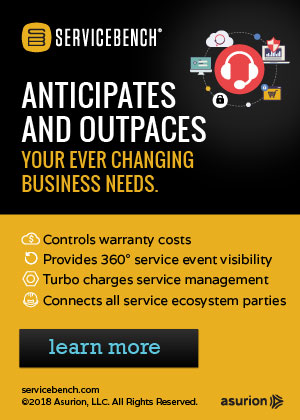Auto Parts Warranties:
Despite the best efforts of the OEMs to push warranty costs back up the supply chain, auto parts makers still have some of the lowest claims rates around. Notable exceptions to this rule include diesel engines and aftermarket replacement parts such as mufflers.
When it comes to warranty expenses, U.S-based automotive parts and component manufacturers are on the good side of the automotive supply chain. For while the big Detroit nameplates pay out anywhere from 2.5% to 4% of their sales revenue in warranty claims, the rate more typical for parts manufacturers is 0.6% of sales.
Supplier recover efforts, however, are beginning to take hold. The big Detroit OEMs are doing all they can to make their suppliers pay their fair share of warranty costs. However, while Warranty Week has documented rising warranty costs for major parts suppliers such as Delphi Corp. and Visteon Corp., we've also seen that costs for their former corporate parents General Motors and Ford also continue to rise, as was detailed in a November 15 article.
As has been the format for the past couple of weeks, let's begin with a quick snapshot of warranty claims across the whole industry. Warranty Week is tracking some 92 different U.S.-based auto parts suppliers, retailers, and aftermarket manufacturers who report their warranty expenses to the U.S. Securities and Exchange Commission. Together, these 92 companies reported $509 million in claims during the quarter ended September 30, up 14% from the same quarter a year ago and up 4% sequentially from the second quarter of 2005.
Double-Digit Annual Growth
So far for the first nine months of 2005, auto parts suppliers have reported $1.45 billion in warranty claims, up 17% from the same period of 2004. If current trends continue, 2005 will end with a noticeable jump for warranty claims in this industry sector. However, this group of 92 suppliers will probably still account for only 7% or 8% of the entire warranty pie, as they have since early 2003.
We should note that there is quite a bit of crossover between this industry sector and others, which is why the totals here may be significantly larger than they have been in past newsletters. As we provide each weekly roundup of a single industry, we broaden our definition of companies within the sector to include manufacturers who are only partially engaged in that line of business. Therefore, in this week's roundup, we're repeating American Standard Companies, which also featured into the HVAC study, and we're also including some consumer electronics suppliers who supply audio and navigational gear for automobiles. Were we to use a more restrictive definition so that any given company would be listed under one and only one industry heading, there might not be 92 companies in this sector.
Here's the chart for warranty expense in the auto parts industry for the past 33 months. As is evident from the data, warranty claims in dollar terms have never been higher, although as a percentage of sales the ratio is more or less within the same 0.5% to 0.7% range we've seen for three years.
Top U.S.-based Auto Parts Manufacturers
Product Warranty Claims
in $ Millions per Quarter
1Q 2003 to 3Q 2005
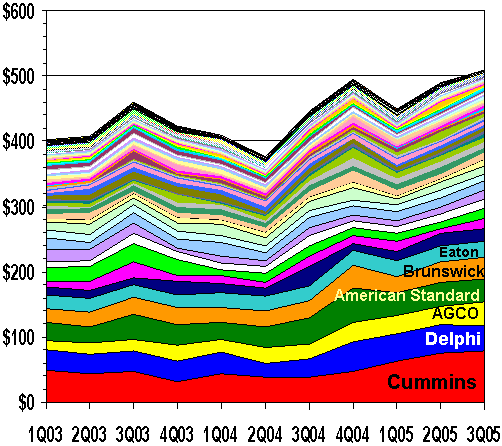
Source: Warranty Week from SEC data
Because none of the 92 manufacturers dominates the industry sector to the extent that GM or Ford do the automotive OEM sector, labels in the above chart were a bit of a tight squeeze. We managed to include six. The next six include Danaher (in navy blue); Johnson Controls (in pink); AutoZone Inc. (in bright green); Standard Motor Products Inc. (in white); Dana Corp. (in lavender); and ArvinMeritor Inc. (in light blue).
The largest slice goes to Cummins Inc., which manufactures diesel engines of all sizes for applications ranging from light trucks to electrical power generation. In many ways, they behave more like an automotive OEM and less like a parts supplier, especially when it comes to warranty payments. In the most recent quarter, Cummins reported a claims rate close to 3%, which is more like what's expected of GM, Ford, or Caterpillar. So far this year, Cummins has paid out $218 million on sales of $7.165 billion.
Cummins Inc.
Warranty Claims & Accruals
in % of Sales & $m per Quarter
1Q 2003 to 3Q 2005
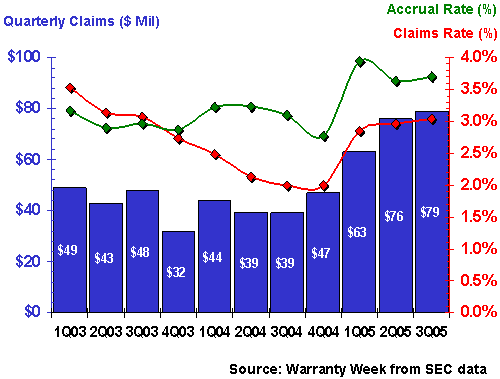
As is evident in the chart above, Cummins now is paying out roughly the same percentage of sales for warranty claims as it did in early 2003. During the second half of 2004, its claims rate dropped as low as 2%, but it has been heading back upwards ever since.
Cummins is not, however, the auto parts supplier with the highest claims rate of all. Among the larger 20, aftermarket muffler supplier Midas Inc. is at the top of the list with a 9.1% claims rate, and aftermarket replacement parts supplier Standard Motor Products Inc. is right behind them with a 6.3% claims rate. Perhaps there's something about business practices in the aftermarket sector that drives up warranty costs for manufacturers?
OEMs vs. Their Spin Offs
Back in what we traditionally would call the auto parts supplier industry, the contrast between high and low claims rates couldn't be clearer than it is with Delphi and Visteon. Spun off from GM and Ford, respectively, in 1999 and 2000, these suppliers have seen their warranty costs rising recently, but they're still only a fraction of the rates seen at their former parents.
Delphi, for instance, has an 0.6% claims rate to GM's 3.0%. Visteon has an 0.2% claims rate to Ford's 2.7%. A year ago, the Delphi/GM rates were 0.4%/2.9% while the Visteon/Ford split was 0.1%/2.5%. So if anything, all four companies have seen an upwards drift in rates, rather than any meaningful shift from OEM back to supplier.
The detailed charts for Delphi and Visteon follow. Readers should consider opening up the November 15 article in a separate window to compare these charts with those published for GM and Ford.
Delphi Corp.
Warranty Claims & Accruals
in % of Sales & $m per Quarter
1Q 2003 to 3Q 2005
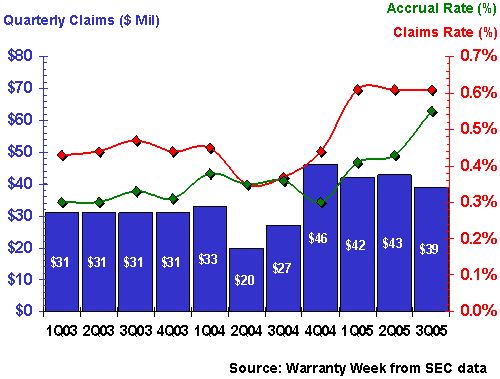
Delphi of course is now in bankruptcy and also is caught in something of a warranty-related accounting scandal with GM. The figures used in 2003 are estimates, because at that time Delphi was not detailing its warranty expenses in its quarterly statements. However, the three-quarter rate stability at 0.6% is real. Even though sales and warranty payments have fluctuated all year, for some reason the latter divided by the former has always worked out to precisely 0.6%.
Visteon has seen a steady rise in its warranty expenses, but they're rising from the super-low level of 0.06% up towards the merely low level of 0.2%. Pessimists could say Visteon's claims rate tripled in two years, but optimists could point out that the claims rate at Ford is 15 times higher as a percentage of automotive sales. They would both be right.
Visteon Corp.
Warranty Claims & Accruals
in % of Sales & $m per Quarter
1Q 2003 to 3Q 2005
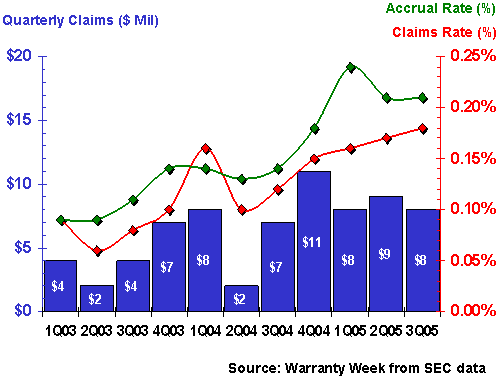
Next we'll take a quick look at two suppliers who are not closely linked to an OEM. ArvinMeritor Inc. was formed in July 2000 through the merger of Arvin Industries Inc. and Meritor Automotive Inc. It manufactures everything from Meritor Wabco air brakes and ZF FreedomLine transmissions for trucks to Gabriel shocks and Purolator oil filters for passenger cars. Intuitively, based on that product mix, one would think the company's warranty experience would be closer to that of an engine manufacturer like Cummins, but it turns out that ArvinMeritor's claims rate is closer to Delphi's.
ArvinMeritor Inc.
Warranty Claims & Accruals
in % of Sales & $m per Quarter
1Q 2003 to 3Q 2005
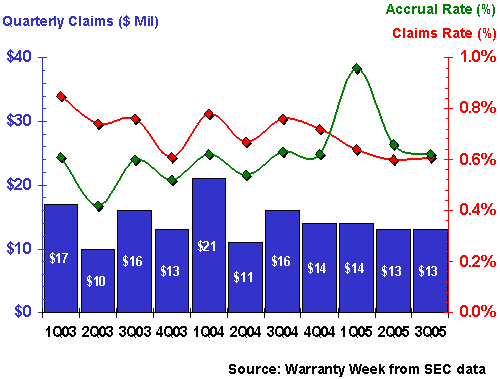
Johnson Controls harkens back to 1883, a time before there were automobiles, when its main line of business was building controls, specifically electric room thermostats. Under the leadership of founder Warren S. Johnson, the company actually did briefly dabble in the automobile manufacturing business, but by mid-20th century the company's focus was back on building controls. Through more recent acquisitions, the company has entered the automobile battery and seating businesses, which is why they're in our roundup this week.
As is obvious in the chart below, except for a one-time hiccup in the third quarter of 2003, the company's warranty claims record has remained very close to 0.2% for the past two years. Sources within the company have said the third quarter 2003 event was nothing more than a case of bad timing: a coincidence of claims coming in early from some OEMs and reimbursements coming in a bit late from some suppliers. But even then, claims never exceeded 0.27% of sales.
Johnson Controls Inc.
Warranty Claims & Accruals
in % of Sales & $m per Quarter
1Q 2003 to 3Q 2005
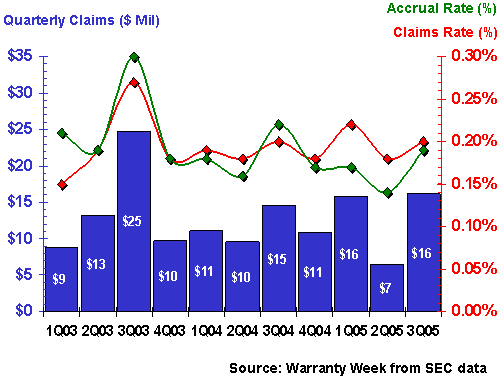
Overall, it does seem as if automotive suppliers fall into several sub-groups based upon where they reside in the supply chain. Those making brakes, seats, dashboards, windows, axles, batteries, and even transmissions seem to fall into a sub-one-percent range when it comes to warranty claims rates. Those making engines fall into the same range as the OEMs themselves. Those in the aftermarket for some reason have seen their claims rates exceed even those reported by the OEMs.
Next week we'll wrap up our warranty roundup with a look at the telecommunications equipment market and then we'll wish all our readers a Merry Christmas, Happy Hanukkah, and a Happy New Year as we take a two-week break.
| Back to Part Five | Go to Part Seven |





